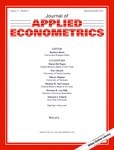
\de Vries\, C. and Sun, P. (2018). Exploiting tail shape biases to discriminate between stable and student t alternatives. Journal of Applied Econometrics, 33(5):708--726.
-
Affiliated author
-
Publication year2018
-
JournalJournal of Applied Econometrics
The nonnormal stable laws and Student t distributions are used to model the unconditional distribution of financial asset returns, as both models display heavy tails. The relevance of the two models is subject to debate because empirical estimates of the tail shape conditional on either model give conflicting signals. This stems from opposing bias terms. We exploit the biases to discriminate between the two distributions. A sign estimator for the second-order scale parameter strengthens our results. Tail estimates based on asset return data match the bias induced by finite-variance unconditional Student t data and the generalized autoregressive conditional heteroscedasticity process.